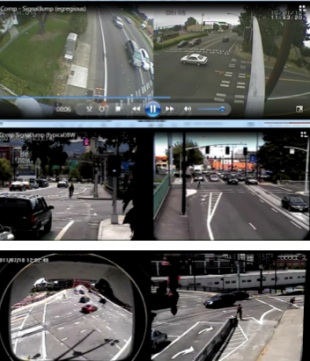
(Photo © J. Maus/BikePortland)
We’ve all met that person who can’t seem to talk about bikes without complaining about “the cyclists” who are “always running” red lights.
Next time you cross paths with them, you might want to mention a new study suggesting that speeding in a car on local streets is at least six times more common than running a red light on a bike.
Nearly 94 percent of people riding bikes in Portland, Beaverton, Corvallis and Eugene stopped for red lights, a forthcoming Portland State University-based study of 2,026 intersection crossing videos has found. Of those, almost all (89 percent of the total) followed the rules perfectly, while another 4 percent entered the intersection just before the light changed to green.
Only 6 percent of riders were observed heading directly through the red light.
“This level of compliance … it’s higher than I would have expected.”
— Chris Monsere, civil engineering professor and director of Intelligent Transportation Lab at PSU
That compares to, for example, an estimated 36 percent to 77 percent of people who tend to break the speed limit when driving a car on local streets, according to previous, otherwise unrelated research. (See p. 2 of the PDF.)
The new finding on bike safety might surprise bike watchers such as, for example, Commissioner Amanda Fritz, who in 2011 mentioned red-light jumpers as a reason to vote against a Portland bikesharing system. The study certainly surprised one person: its author, PSU civil engineering professor Chris Monsere.
“This level of compliance … it’s higher than I would have expected,” Monsere said Monday. “Pedestrian compliance with signals downtown is nowhere near that.”
The videos captured people crossing the intersection during daylight hours, both weekdays and weekends, in various urban and suburban settings. The figures don’t include people turning right against red lights.

(Image taken from study)
Monsere said few academics seem to have studied how people use their bikes at red lights, so it’s not clear whether Oregonians are unusually law-abiding. Two weeks ago, Chicago’s transportation department touted new bike signals on Dearborn Avenue that it said had nearly tripled stoplight compliance by people on bikes … from 31 percent to 81 percent.
But that pattern doesn’t seem to hold up in Monsere’s study, which found no significant difference in behavior between intersections with dedicated bike signals and those without.
People who run red lights on bikes were less likely to wear a helmet: more than 15 percent of people without helmets pedaled through the light, compared to 4 percent of those with.
“It’s risk-taking behavior,” Monsere said.
Monsere’s study, which he made available in draft form because it’s still awaiting peer review, was jointly funded by the Oregon Transportation Research and Education Consortium and Oregon Department of Transportation.
Is it possible that, much like more bikes on a street seem to make it safer for everyone, more bikes at an intersection tend to make everyone more law-abiding?
That’s one theory from Peter Koonce, the City of Portland’s top expert on stoplights. And that’s why he suspects Portland red light compliance is so high.
“You have to have a little bit of gall to pass the crowd and blow the red light when there’s six or seven or eight other people there,” Koonce said.

